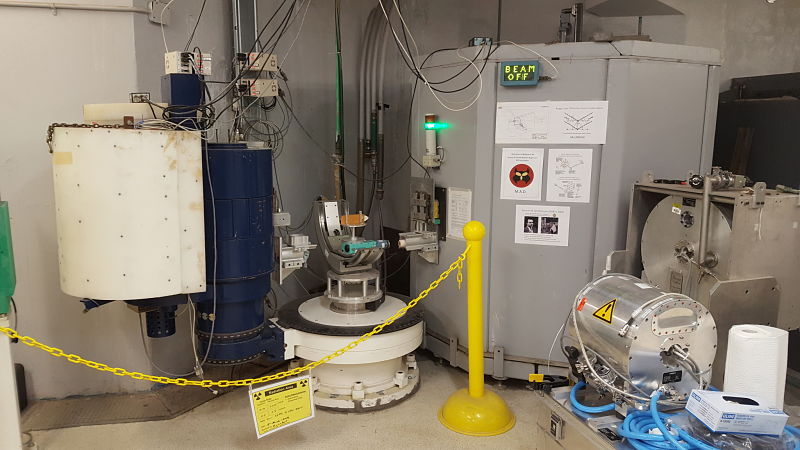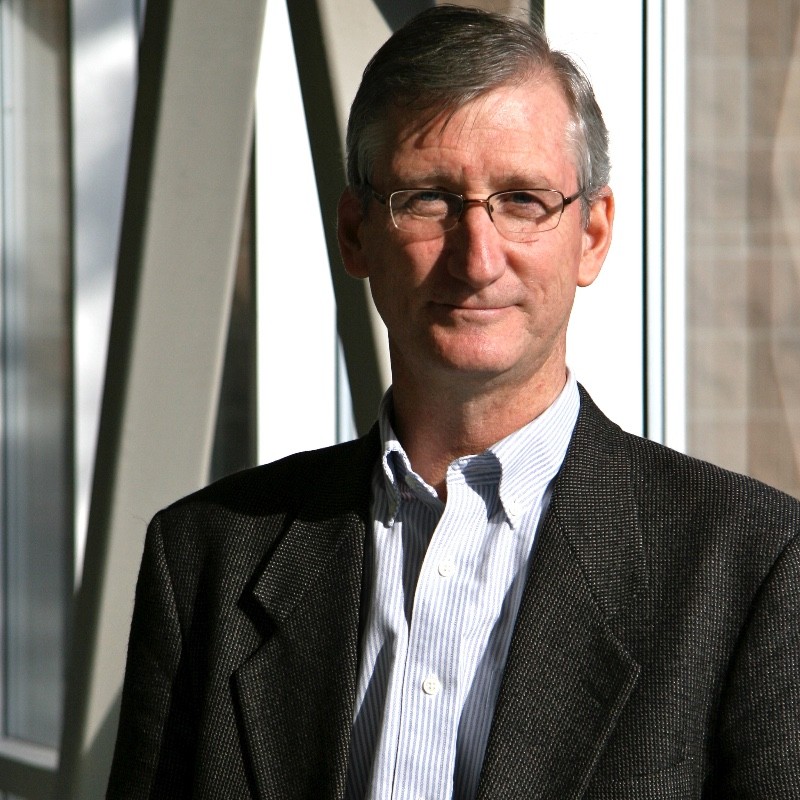Overview
Innovation in materials underpins technology solutions that address challenges related to the environment, human health and the information age. Neutrons can penetrate deep into matter, enabling researchers to characterize the interior structures of a wide variety of substances at the atomic level. This capability is in contrast to many other probes that are sensitive only to surfaces (for example, electrons or positrons) or to near-surface regions (x-rays).
Thousands of research teams across Canada study materials and inevitably, many researchers encounter materials problems which can only be solved using neutron beams.
McMaster is creating a national neutron beam user facility at the McMaster Nuclear Reactor (MNR) to provide access to these versatile and irreplaceable probes of materials for researchers at the University and all over Canada.
MNR is currently home to two neutron scattering beamlines. These two beamlines are to open as user facilities soon, with three more to be completed over the next several years. The latter three are newly funded through the CFI 2020 Innovation Fund project “Building a Future for Canadian Neutron Scattering,” a national collaboration of 17 universities.
Completion of this expansion of the neutron beam lab at MNR is a priority of the national neutron user community identified in the Canadian Neutron Long Range Plan for 2025 to 2035.
For general inquires or to request access to the beamlines, please email us.
Beamlines
There are five neutron beamlines in operation or under construction at MNR.
For general inquires or to request access to the beamlines, please email us.
McMaster Small Angle Neutron Scattering Facility (MacSANS)
The McMaster Small Angle Neutron Scattering (MacSANS) beamline is nearing completion. When complete, SANS will be unique in Canada and will support more than 25 research groups at McMaster and other universities.
MacSANS will probe the structures of biomaterials and other materials with large molecules to study their properties on a length-scale up to 100 nm. This scale is appropriate for studying cellular membranes or nanoparticles. Steel processing companies have used SANS to characterize precipitates in their steel products as they develop products with enhanced strength and toughness to ensure the long-term reliability of pipelines and other steel structures. Until now, Canadians have had to go outside of Canada to use this technique.
A key component of the SANS facility is its subterranean guide-hall. This feature will allow researchers to maximize the distance between their samples and the detector, enabling them to accurately measure very small angles of diffraction that are otherwise too small to be observed.
Staff contact: Mitchell DiPasquale


McMaster Alignment Diffractometer (MAD)
Located on Beamport #6 in the McMaster Nuclear Reactor, the McMaster Alignment Diffractometer (MAD) is currently the only instrument in Canada capable of performing neutron diffraction and inelastic neutron scattering measurements.
MAD is a general purpose triple-axis spectrometer, primarily used for neutron diffraction measurements to align and evaluate the quality of single crystal and polycrystalline samples. MAD can also be used for more advanced characterization measurements such as: determination of crystal structures, identification of magnetically ordered ground states, characterization of phase transitions, and investigation of magnetic and vibrational dynamics (e.g. magnons and phonons). MAD is also available for educational use (e.g. demonstration experiments). MAD is built on the site of Bertram Brockhouse’s original McMaster triple-axis spectrometer, based on the same design that helped to earn Brockhouse the 1994 Nobel Prize in Physics.
Staff contacts: Pat Clancy and Bo Yuan.
Powder diffractometer
A new powder diffractometer is being designed for MNR. Powder diffractometers are some of the most prolific neutron instruments. They are in high demand for determining the chemical and magnetic crystallography of new materials and for establishing structure-property relationships and phase behaviour in a broad range of hard materials.
We will build a new instrument optimized to collect diffraction patterns over a 120° horizontal scattering angle (and 11° vertically) using a two-dimensional position-sensitive detector filled with 3He gas. Geometric calculations show that its data collection rates will be at least as good as, if not better than, the C2 instrument.
The instrument will be essential for many Canadian research programs. For example, powder neutron diffraction is the only technique for locating hydrogen in the unit cell of metal hydrides during in situ studies of hydrogen absorption and desorption, which is critical to determining how the metal alternates between hydrided and dehydrided phases. It is essential for solving the crystal and magnetic structures that produce the behaviours of thermoelectric and magnetocaloric materials and of permanent magnets that enable more energy-efficient technologies. It is essential for observing the locations of small ions in battery electrodes; determining the influence of minority alloying elements on strength; and observing the way that texture is inherited through phase transformations. It also is central to understanding how the chemical and magnetic structures relate to the electrical and magnetic properties in many quantum materials.
Stress-scanner
The L3 neutron stress-scanner is being relocated to MNR from the Canadian Neutron Beam Centre (CNBC). Neutron stress-scanners are frequently used by industry and university-industry collaborations to determine internal stresses in metallic parts that are safety-critical components of a structure, machine, or vehicle. The stress-scanner at the CNBC was used for most of this research in Canada until the CNBC closed in 2018. This instrument offers submillimetre sampling volume and is optimized for precise measurements of lattice strain (±1×10-4) as a function of position (±10 μm) within engineering components.
Neutron stress-scanning is the only non-destructive means to determine stresses deep within the same metallic part (e.g. components of a car or boat engine) both before and after it undergoes manufacturing processes such as heat treatment for relieving stress. It is often the only means to observe how stresses relax in alloys at elevated temperatures, which is needed to understand how materials behave around flaws (e.g. small cracks) in nuclear reactor components and hence to predict safe operating margins of power plants.
Reflectometer
The D3 reflectometer is being relocated to MNR from the CNBC. Neutron reflectometers are high-demand instruments, typically oversubscribed by factors of 2 to 3. Due to an ever-increasing interest in the industrial applications of thin films and membranes, neutron reflectometry will continue to be an essential research tool well into the future. MNR’s reflectometer is optimized for determining chemical and magnetic profiles as a function of depth into the surface of materials fabricated as thin films or multilayers.
The reflectometer enjoyed a multidisciplinary user base at the CNBC. Neutron reflectometry is the only technique that has enough sensitivity to hydrogen atoms to determine the amounts and locations of hydrogen in copper coatings, and to track changes in these parameters non-destructively and in situ under changing physical, electrochemical, and environmental conditions. It is essential for developing bio-nanotechnologies for which understanding polymer coatings on surfaces or water-polymer interactions is critical, such as nanocellulose for reinforcement applications, or anti-biofouling coatings for medical implants, tests, and sensors. It is also essential for identifying skyrmions in thin films of quantum magnetic metals.
People
For general inquires or to request access to the beamlines, please email us.
Information Box Group
Bruce Gaulin
Distinguished University Professor,
Physics & Astronomy
Brockhouse Chair in the Physics of Materials
Research Interests: Geometrically frustrated magnets, Quantum Magnets with singlet ground states, High temperature superconductors.
Dr. Bruce Gaulin is an experimental condensed matter physicist, working in the general area of scattering studies of exotic ground states in new, mostly magnetic, materials. Dr. Gaulin’s team makes new materials which they think will have interesting and exotic ground states, and then take these materials to forefront neutron and x-ray scattering facilities in North America and around the world. They perform scattering experiments on these new materials and then work either independently or with friends in theory to interpret the experiments, and thereby shed light on the exotic properties of the new materials.

Bruce Gaulin
Distinguished University Professor,
Physics & Astronomy
Brockhouse Chair in the Physics of Materials
Pat Clancy
Assistant Professor,
Physics & Astronomy
Research Interests: The study of novel materials using x-ray and neutron scattering techniques.
Zin Tun
Adjunct Assistant Professor, Physics & Astronomy
Director of Instrument Development
Consultant, TVB Associates Inc.
Research Interests: Development of neutron sources, beam lines, and instrumentation
Dr. Zin Tun has been the scientific project leader for the design and construction of three neutron beamlines, including MacSANS valued at over $10M located at the former Canadian Neutron Beam Centre or the McMaster Nuclear Reactor (MNR). He is presently serving as the Director of Instrument Development for implementation of the CFI award, “Building a Future for Canadian Neutron Scattering” which will add three new neutron instruments to MNR. He is Canada’s most experienced expert on the design and construction of neutron beamlines.

Zin Tun
Adjunct Assistant Professor, Physics & Astronomy
Director of Instrument Development
Consultant, TVB Associates Inc.
Bo Yuan
Postdoctoral Fellow
Instrument Scientist for MAD
Bo Yuan is currently an NSERC postdoctoral fellow jointly supervised by Bruce and Pat Clancy. His research focusses on understanding the microscopic magnetic interactions in a broad range of quantum materials, ranging from transition metal to rare earth compounds. He employs a broad range of bulk measurement techniques and diffraction/spectroscopy techniques using X-ray and neutrons. In addition to research in condensed matter physics, he is also a part of the neutron beam instrument team at the McMaster Nuclear Reactor (MNR). He is currently responsible for maintaining and running user-experiments on the McMaster Alignment Diffractometer, a triple-axis instrument. He is also involved in the development of the new suite of neutron instruments.
He carried out his doctoral work at University of Toronto with Prof. Young-June Kim where he carried neutron and X-ray scattering study of a broad range of quantum magnets. Before joining McMaster, he did a short 1-year postdoc at the Max Planck Institute for Structure and Dynamics of Matter at Hamburg with Prof. Andrea Cavalleri, where he carried out pump probe experiments to study the non-equilibrium properties of quantum materials under intense laser field.
Bruce Gaulin
Distinguished University Professor,
Physics & Astronomy
Brockhouse Chair in the Physics of Materials
Research Interests: Geometrically frustrated magnets, Quantum Magnets with singlet ground states, High temperature superconductors.
Dr. Bruce Gaulin is an experimental condensed matter physicist, working in the general area of scattering studies of exotic ground states in new, mostly magnetic, materials. Dr. Gaulin’s team makes new materials which they think will have interesting and exotic ground states, and then take these materials to forefront neutron and x-ray scattering facilities in North America and around the world. They perform scattering experiments on these new materials and then work either independently or with friends in theory to interpret the experiments, and thereby shed light on the exotic properties of the new materials.
Bruce Gaulin
Distinguished University Professor,
Physics & Astronomy
Brockhouse Chair in the Physics of Materials
Research Interests: Geometrically frustrated magnets, Quantum Magnets with singlet ground states, High temperature superconductors.
Dr. Bruce Gaulin is an experimental condensed matter physicist, working in the general area of scattering studies of exotic ground states in new, mostly magnetic, materials. Dr. Gaulin’s team makes new materials which they think will have interesting and exotic ground states, and then take these materials to forefront neutron and x-ray scattering facilities in North America and around the world. They perform scattering experiments on these new materials and then work either independently or with friends in theory to interpret the experiments, and thereby shed light on the exotic properties of the new materials.
Pat Clancy
Assistant Professor,
Physics & Astronomy
Research Interests: The study of novel materials using x-ray and neutron scattering techniques.
Pat Clancy
Assistant Professor,
Physics & Astronomy
Research Interests: The study of novel materials using x-ray and neutron scattering techniques.
Zin Tun
Adjunct Assistant Professor, Physics & Astronomy
Director of Instrument Development
Consultant, TVB Associates Inc.
Research Interests: Development of neutron sources, beam lines, and instrumentation
Dr. Zin Tun has been the scientific project leader for the design and construction of three neutron beamlines, including MacSANS valued at over $10M located at the former Canadian Neutron Beam Centre or the McMaster Nuclear Reactor (MNR). He is presently serving as the Director of Instrument Development for implementation of the CFI award, “Building a Future for Canadian Neutron Scattering” which will add three new neutron instruments to MNR. He is Canada’s most experienced expert on the design and construction of neutron beamlines.
Zin Tun
Adjunct Assistant Professor, Physics & Astronomy
Director of Instrument Development
Consultant, TVB Associates Inc.
Research Interests: Development of neutron sources, beam lines, and instrumentation
Dr. Zin Tun has been the scientific project leader for the design and construction of three neutron beamlines, including MacSANS valued at over $10M located at the former Canadian Neutron Beam Centre or the McMaster Nuclear Reactor (MNR). He is presently serving as the Director of Instrument Development for implementation of the CFI award, “Building a Future for Canadian Neutron Scattering” which will add three new neutron instruments to MNR. He is Canada’s most experienced expert on the design and construction of neutron beamlines.
Bo Yuan
Postdoctoral Fellow
Instrument Scientist for MAD
Bo Yuan is currently an NSERC postdoctoral fellow jointly supervised by Bruce and Pat Clancy. His research focusses on understanding the microscopic magnetic interactions in a broad range of quantum materials, ranging from transition metal to rare earth compounds. He employs a broad range of bulk measurement techniques and diffraction/spectroscopy techniques using X-ray and neutrons. In addition to research in condensed matter physics, he is also a part of the neutron beam instrument team at the McMaster Nuclear Reactor (MNR). He is currently responsible for maintaining and running user-experiments on the McMaster Alignment Diffractometer, a triple-axis instrument. He is also involved in the development of the new suite of neutron instruments.
He carried out his doctoral work at University of Toronto with Prof. Young-June Kim where he carried neutron and X-ray scattering study of a broad range of quantum magnets. Before joining McMaster, he did a short 1-year postdoc at the Max Planck Institute for Structure and Dynamics of Matter at Hamburg with Prof. Andrea Cavalleri, where he carried out pump probe experiments to study the non-equilibrium properties of quantum materials under intense laser field.
Bo Yuan
Postdoctoral Fellow
Instrument Scientist for MAD
Bo Yuan is currently an NSERC postdoctoral fellow jointly supervised by Bruce and Pat Clancy. His research focusses on understanding the microscopic magnetic interactions in a broad range of quantum materials, ranging from transition metal to rare earth compounds. He employs a broad range of bulk measurement techniques and diffraction/spectroscopy techniques using X-ray and neutrons. In addition to research in condensed matter physics, he is also a part of the neutron beam instrument team at the McMaster Nuclear Reactor (MNR). He is currently responsible for maintaining and running user-experiments on the McMaster Alignment Diffractometer, a triple-axis instrument. He is also involved in the development of the new suite of neutron instruments.
He carried out his doctoral work at University of Toronto with Prof. Young-June Kim where he carried neutron and X-ray scattering study of a broad range of quantum magnets. Before joining McMaster, he did a short 1-year postdoc at the Max Planck Institute for Structure and Dynamics of Matter at Hamburg with Prof. Andrea Cavalleri, where he carried out pump probe experiments to study the non-equilibrium properties of quantum materials under intense laser field.




